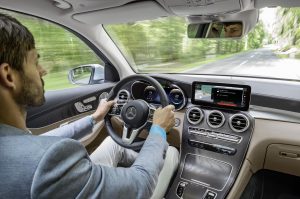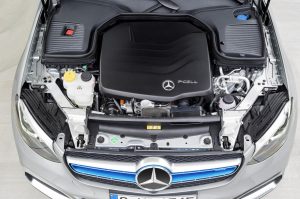At this week’s Frankfurt auto show, automakers will be vying to show that Tesla won’t overtake them by introducing a passel of battery-electric vehicles themselves. Here’s a look from Clean Fleet Report of one of those new electrified cars that you could be driving by the end of this decade.
Frankfurt Motor Show Sees Advances on Hydrogen Front
Mercedes-Benz arrived at the Frankfurt Motor Show with a pre-production plug-in fuel-cell version of its GLC F-Cell, ahead of its showroom debut next year. The GLC F-Cell is exactly what the name suggests: a fuel-cell version of Mercedes’ GLC-Class compact crossover/SUV that has been rolling off the production line since July 2015.

A prototype model was seen at the 2016 Paris Motor Show, and the pre-production GLC F-Cell’s powertrain is a near duplication. It features both a fuel-cell stack and a lithium-ion battery pack that can be recharged by pluggin in, an industry first.
Fill Up With Hydrogen—Or, Plug It In
The centerpiece of the GLC F-Cell EQ Power’s technology, the fuel-cell stack, was developed in Vancouver, Canada, together with partner Ford in the Automotive Fuel Cell Cooperation (AFCC) joint venture. Around 30 percent more compact than previous stacks, it can be fully housed in the engine bay for the first time. Furthermore, the cost of the fuel cell stack technology has been slashed thanks largely to a 90-percent reduction in the amount of platinum used in the stack.
Electrical energy used to power the GLC F-Cell’s electric motors is generated on board within the fuel cell stack in a reaction between compressed hydrogen and oxygen. Two carbon-fiber-encased tanks are located in the middle and under the rear seats, storing four kilograms of hydrogen. Mercedes states that the tanks can be refilled within three minutes and provide 271 miles of emissions-free driving range.

A 13.8-kilowatt-hour lithium-ion battery is housed at the rear of the SUV to save space and provides about 30 miles of battery-electric driving, for a total range of 301 miles. Regenerative braking allows energy to be recuperated and stored in the battery during braking and coasting phases. Like plug-in hybrid or electric vehicles, the battery can be recharged using a standard 120-volt household outlet, a home recharger or a public charging station.
Combined output for the rear-wheel drive luxury crossover is about 197 horsepower and a hearty 258 pounds-feet of torque. Charging time for the battery on a standard household outlet using the 7.2 kW on-board chargers takes just 1.5 hours. The GLC F-Cell will have three driving modes (Eco, Comfort and Sport), as well as four operating modes (Hybrid, F-Cell, Battery and Charge).
The Mercedes GLC F-Cell will go on sale in the U.S. by the end of 2019, but it’s unlikely that it will be sold outside of California, as there are only 40 hydrogen refueling stations available in the U.S. and all but four of them are in California.

6 thoughts on “News: 2019 Mercedes-Benz GLC F-Cell Combines Plug-In + Fuel Cell”